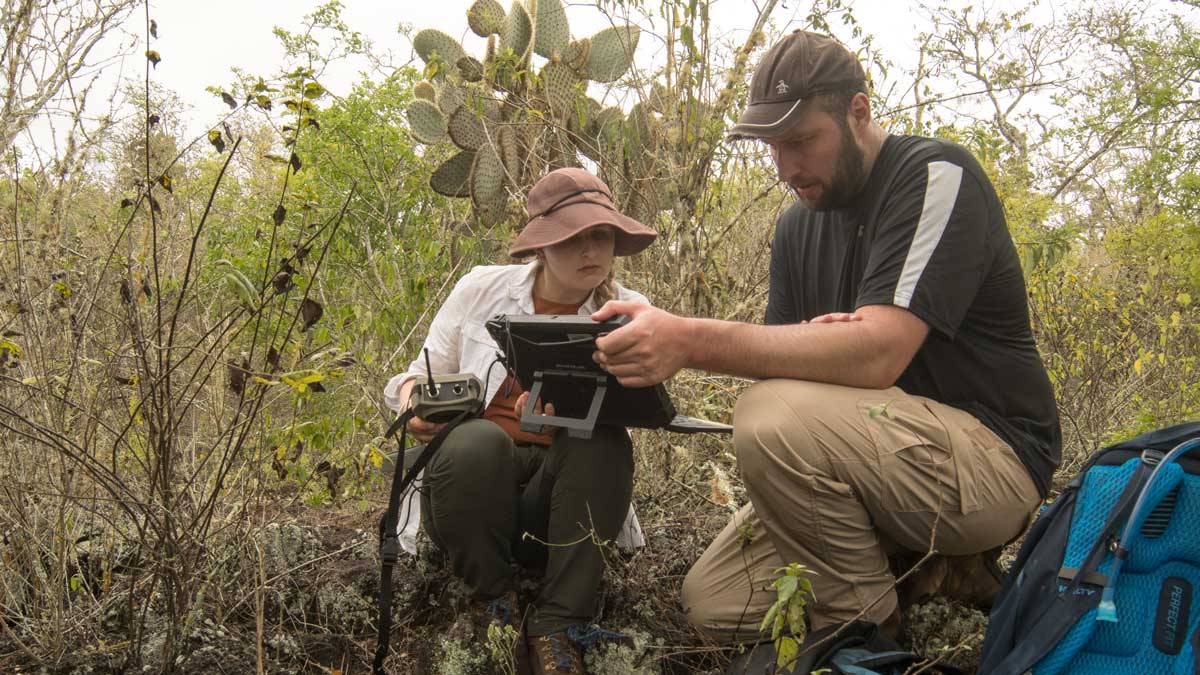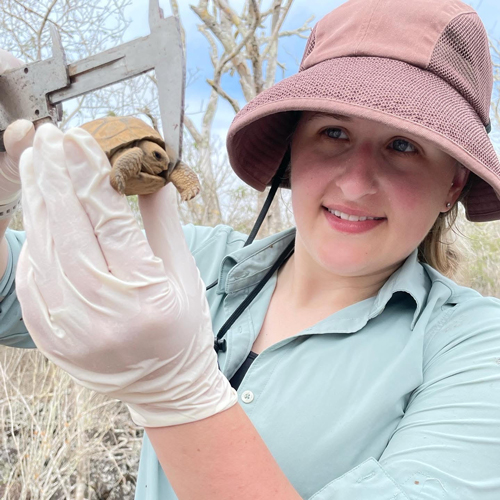
(Top) As part of her research on the reproductive ecology of giant tortoises in the Galapagos Islands, Emily Donovan, a doctoral student, and Guillaume Bastille-Rousseau, assistant professor at SIU, program a GPS tag attached to a nearby animal. (Below) Donovan measures a young giant tortoise while conducting research.
May 11, 2023
SIU doctoral student probes Galapagos tortoises’ little-known reproductive ecology
CARBONDALE, Ill. – As legendary as they are, and as long-lived (up to 200 years or so), one might think science knows a lot about the giant tortoises of the Galapagos Islands. But a doctoral student at Southern Illinois University Carbondale says there are surprising gaps in that knowledge, especially when it comes to reproduction.
Emily Donovan spent months in the biologically renowned area trying to unlock such secrets. Donovan wants to help assure management plans will ensure the gentle giants thrive into the future.
The International Union for Conservation of Nature lists the giant tortoise species between “vulnerable” to “critically endangered,” signaling its precarious niche in the biosphere, Donovan said.
“Despite how iconic giant tortoises are, we know surprisingly little about their life history, especially as it relates to reproductive ecology,” Donovan said. “This is a problem when we think about how to help them to recover in the face of challenges such as climate change and conflicts with introduced species.”
Call of the wild
The Galapagos Islands first burst into the world’s consciousness following Charles Darwin’s landmark work on evolution. Renowned for being home to unique and endemic species, the islands were a centerpiece of Darwin’s work, which ultimately produced the book “On the Origin of Species.”
The significance wasn’t lost on Donovan.
“The idea of studying there was very exciting,” she said. “But even beyond simply how interesting the animals and location are, I was also very interested in this project because of its implications for conservation of species, which have been imperiled by human influences for centuries.”
In it for the long haul
Donovan began her dissertation work at SIU in January 2022 with Guillaume Bastille-Rousseau, assistant professor with SIU’s Cooperative Wildlife Research Laboratory, who has considerable experience working on the subject.
During his post-doctoral work, Bastille-Rousseau analyzed a massive dataset of the movements of four species of Galapagos tortoises. The goal was to identify what was driving the movement, as some of the animals would migrate up and down volcanoes while others would stay in one area year-round.
Bastille-Rousseau’s work, along with others, led to a good understanding of how the environment of the different islands impact tortoise movement and why some tortoises decide to undertake yearly migration. Left unanswered, however, was how this variation in migration habits impacted reproduction.
“Movement ecologists like me often study why animals differ in their movement behaviors, but we often struggle with understanding how this variation is linked to survival or reproduction, and therefore how much does it matter for a species,” he said. “Emily’s research fills that gap.”
“For example, one question would be whether the migrating tortoises produce more eggs,” he said. “And that, specifically, is what Emily’s project is trying to address. Building on over a decade of research on tortoise movement, Emily is basically asking, ‘Does the observed variation in movement matter?’”
What’s the payoff?
Donovan made her first trip to the islands last summer, spending two months on Santa Cruz Island. Summer here is the cool season there, and it’s during that time that the female tortoises nest. In fact, the nesting period for the animal can last from June through November.
Evaluating the success of these various movement strategies means tracking tortoises. So, Donovan began following 20 GPS-tagged females from the eastern Santa Cruz population. The cohort contained a mixture of seasonal migrants and year-round residents in the nesting zone.
As that nesting season unfolded, Donovan and Bastille-Rousseau assisted a group of technicians using a portable x-ray machine to take radiographs of each subject every three weeks, counting the number of eggs each was carrying at any given time and getting an overall seasonal count of what each produced. Cross-referencing the x-ray egg data with the GPS data and trail camera recordings revealed when and where each of tortoises nested throughout the season.
In January, Donovan returned to the island for several weeks to study the hatching season, which can last through April.
 “By the end of the nesting season, we had identified and marked nearly 50 tortoise nests that were laid by our study females,” she said. “Then, as the eggs hatched, we returned to the nests to determine outcomes and to collect genetic samples from the hatchlings.”
“By the end of the nesting season, we had identified and marked nearly 50 tortoise nests that were laid by our study females,” she said. “Then, as the eggs hatched, we returned to the nests to determine outcomes and to collect genetic samples from the hatchlings.”
She continues collecting data with the help of fellow researchers who live and work in the Galapagos Islands and plans to return to the location for two months this summer and again for a fourth time during the following hatching season.
While the data collection and analysis are underway, some exciting findings are beginning to emerge, she said.
“For example, while we knew it was possible for the wild tortoises to nest more than once in a season, we were surprised to see that nearly all the tracked females nested more than once, and some as many as four times,” Donovan said. The x-ray work also revealed important biological information, such as variations in clutch sizes and egg production times among individuals and even with the same tortoise, she said.
“We are hoping to collect another two full years’ worth of data for my dissertation, and my analyses will conclude after that,” Donovan said. “But considering Galapagos tortoises may live up to 200 years, I hope that the tortoises we are tracking will continue to reveal information important for the conservation of their species for decades to come.”
Bastille-Rousseau said Donovan’s research is shedding light in areas where scientists need further understanding.
“We know very little about giant tortoises and in general about tortoise and turtle reproductive ecology. The first few years of their lives are often called ‘the lost years,’ given how little we know about that part of their lives,” he said.
Looking ahead
Donovan’s work is part of the larger, overarching Galapagos Tortoise Movement Ecology Programme. The GTMEP has been tracking giant tortoises since 2009 and is a collaboration among the Charles Darwin Foundation, the Galapagos National Park Directorate and the Saint Louis Zoo Institute for Conservation Medicine.
After completing her doctorate at SIU, Donovan said she hopes to continue participating in meaningful wildlife conservation research that will help wildlife managers conserve habitat and the animals that use it. SIU is playing a major role in those plans with both the Delyte and Dorothy Morris Doctoral Fellowship and the expertise of faculty.
“The university is supporting my current learning and growth as a scientist,” she said.
